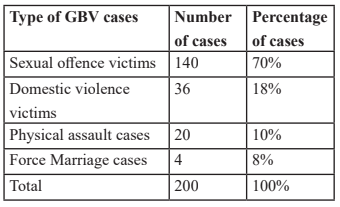Abstract
Background:The OCMC (One stop crisis manage-
ment center) has been established in the recognized-
government hospitals of Nepal. The OCMC has
builtcoalition and create an organizational manage-
ment system with other organizations for providing
comprehensive health and treatment services, legal
aid services, and counseling services and make cer-
tain protection to the survivors of GBV (Gender
based violence) as well as to manage and control
GBV incident.Worldwide more than 119 countries
have laws on domestic violence, 125 countries
have laws on sexual pestering and 52 coun-
tries have laws on marital rape but still women are
suffering from different physical, sexual and Psy-
chological violence. Rape, hurt/battery, Indecent as-
sault, are the main forms of violence.
Materials and Methods: Study is conducted in
Western regional Hospital Pokhara, in OCMC (One
stop crisis management center).It is a cross-section-
al type of study. Data collected by the observation,
interview and case study from the survivors of vi-
olence, available published materials related to
women Violence and OCMC are also studied. Total
200 cases of GBV survivors came to OCMC cen-
ter of Kaski from 2073Baisakh to 2074Ashad and
included in the study as a primary source of data.
Conclusion and Result:Out of total 200 cases,
sexual offence victims were maximum in number
which was 140 and least were forced marriage vic-
tim which were only 4 in number. More than 50% of
dalit caste people were the survivors of GBV cases.
GBV cases were predominant in age group of 20-
30 years. Maximum numbers of victims of GBV in
sexual offence cases were alleged Rape cases which
accounts 85% of total cases came to OCMC center.
References
regional estimates of violence against women:
prevalence and health effects of intimate partner
violence and non-partner sexual violence
2.United Nations Economic and Social Affairs
(2015). The World’s Women 2015, Trends and
Statistics, p.159.
3.Muluki ain-general code with latest amendment
2068, Part-4, chapter 14, On rape, number 1.
4.Muluki ain-general code with latest amendment
2068, Part-4, chapter 9, Hurt/ battery ,number 1and
2
5.Muluki ain-general code with latest amendment
2068, Part-4, chapter 13, On intension of sex, num-
ber 1
6. SAATHI, The Asia Foundation. 1997. A situational analysis of violence against women and girls in
Nepal. Online Library: Addressing Child Traffick-
ing website. http://www.childtrafficking.com/Docs/
situation_analysis_violence_womenngirls_070402.
pdf.
7. Women’s Rehabilitation Centre (WOREC):
Breaking the Silence: Needs Identification of Vic-
tims of Gender-based Violence. Kathmandu, Nepal
2002
8. Deuba AR, Sana PS, SAMANATA, et al. 2005. A
Study on Linkage between Domestic Violence and
Pregnancy. Kathmandu: SAMANTA-Institute for
Social and Gender Equity
9. Puri M, Forst M, Tamang J, et al.. The prevalence
and determinants of sexual violence against young
married women by husbands in rural Nepal. BMC
Research Notes.2012; 5(1):291
10. Nepal Ministry of Health and Population,
New ERA, ICF International. 2012. Nepal demo-
graphic and health survey 2011. DHS Program
website. http://dhsprogram.com/pubs/pdf/FR257/
FR257%5B13April2012%5D.pdf.
11. Himalayan Human Rights Monitors/PPCC, En-
abling State Programme (ESP/DFID). 2012. Sexual
violence assessment in seven districts in Nepal: A
study conducted in Kanchanpur, Kailali, Bardiya,
Banke, Dang, Parsa, and Bara. Himalayan Human
Rights website. http://www.himrights.org/down-
load/12_1633811810.pdf.
12. Brignall, S. and Modell, S., An institutional per-
spective on performance measurement and manage-
ment in the ‘new public sector’. Management ac-
counting research, 2000;11(3), p.281-306
13. Puri M, Forst M, Tamang J, et al.The prevalence
and determinants of sexual violence against young
married women by husbands in rural Nepal. BMC
Research Notes. 2012.5(1):291.
14. Joshi SK..Violence against Women (VAW) in
Nepal: Role of health care workers.Kathmandu
University Medical Journal.2009;7: p89–91
15. Colombini, M., Ali, S.H., Watts, C. and May-
hew, S.H.,. One stop crisis centres: A policy analysis
of the Malaysian response to intimate partner vi-
olence. Health research policy and systems,2011;
9(1), p.25.

